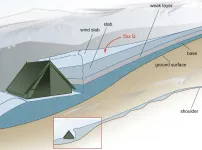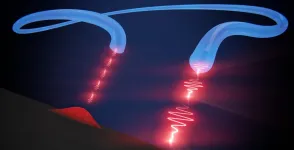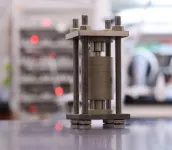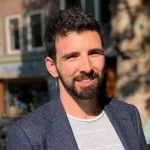(Press-News.org) In early October 2019, when an unknown caller rang EPFL professor Johan Gaume's cell phone, he could hardly have imagined that he was about to confront one of the greatest mysteries in Soviet history. At the other end of the line, a journalist from The New York Times asked for his expert insight into a tragedy that had occurred 60 years earlier in Russia's northern Ural Mountains - one that has since come to be known as the Dyatlov Pass Incident. Gaume, head of EPFL's Snow and Avalanche Simulation Laboratory (SLAB) and visiting fellow at the WSL Institute for Snow and Avalanche Research SLF, had never heard of the case, which the Russian Public Prosecutor's Office had recently resurrected from Soviet-era archives. "I asked the journalist to call me back the following day so that I could gather more information. What I learned intrigued me."
A sporting challenge that ended in tragedy
On 27 January 1959, a ten-member group consisting mostly of students from the Ural Polytechnic Institute, led by 23-year-old Igor Dyatlov - all seasoned cross-country and downhill skiers - set off on a 14-day expedition to the Gora Otorten mountain, in the northern part of the Soviet Sverdlovsk Oblast. At that time of the year, a route of this kind was classified Category III - the riskiest category - with temperatures falling as low as -30°C. On January 28, one member of the expedition, Yuri Yudin, decided to turn back. He never saw his classmates again.
When the group's expected return date to the departure point, the village of Vizhay, came and went, a rescue team set out to search for them. On 26 February, they found the group's tent, badly damaged, on the slopes of Kholat Syakhl - translated as "Death Mountain" - some 20 km south of the group's destination. The group's belongings had been left behind. Further down the mountain, beneath an old Siberian cedar tree, they found two bodies clad only in socks and underwear. Three other bodies, including that of Dyatlov, were subsequently found between the tree and the tent site; presumably, they had succumbed to hypothermia while attempting to return to the camp. Two months later, the remaining four bodies were discovered in a ravine beneath a thick layer of snow. Several of the deceased had serious injuries, such as fractures to the chest and skull.
What exactly happened?
The Soviet authorities investigated to determine the causes of this strange drama, but closed it after three months, concluding that a "compelling natural force" had caused the death of the hikers. In the absence of survivors, the sequence of events on the night of 1 to 2 February is unclear to this day, and has led to countless more or less fanciful theories, from murderous Yeti to secret military experiments.
This is the mystery that Gaume was confronted with. "After the call from the New York Times reporter, I began writing equations and figures on my blackboard, trying to understand what might have happened in purely mechanical terms," he says. "When the reporter rang back, I told her it was likely that an avalanche had taken the group by surprise as they lay sleeping in the tent." This theory, which is the most plausible, was also put forward by the Russian Public Prosecutor's Office after the investigation was reopened in 2019 at the request of the victims' relatives. But the lack of evidence and the existence of odd elements has failed to convince a large portion of Russian society. "I was so intrigued that I began researching this theory more deeply. I then contacted Professor Alexander Puzrin, chair of Geotechnical Engineering at ETH Zurich, whom I had met a month earlier at a conference in France."
Gaume, originally from France, and Russian-born Puzrin worked together to comb through the archives, which had been opened to the public after the fall of the Soviet Union. They also spoke with other scientists and experts in the incident, and developed analytical and numerical models to reconstruct the avalanche that may have caught the nine victims unaware.
"The Dyatlov Pass mystery has become part of Russia's national folklore. When I told my wife that I was going to work on it, she looked at me with deep respect!" says Puzrin. "I was quite keen to do it, especially because I had started working on slab avalanches two years earlier. My primary research is in the field of landslides; I study what happens when a certain amount of time elapses between when a landslide is triggered and when it actually occurs." According to Gaume and Puzrin, this is what happened in 1959: the hikers had made a cut in the mountain's snow-covered slope to set up their tent, but the avalanche didn't occur until several hours later.
Bridging the gaps in the investigation
"One of the main reasons why the avalanche theory is still not fully accepted is that the authorities have not provided an explanation of how it happened," says Gaume. In fact, there are a number of points that contradict that theory: first, the rescue team did not find any obvious evidence of an avalanche or its deposition. Then the average angle of the slope above the tent site - less than 30° - was not steep enough for an avalanche. Also, if an avalanche occurred, it was triggered at least nine hours after the cut was made in the slope. And finally, the chest and skull injuries observed on some victims were not typical of avalanche victims.
In their investigation, published in Communications Earth & Environment - a journal by Nature Research - on January 28, Gaume and Puzrin attempt to address these points. "We use data on snow friction and local topography to prove that a small slab avalanche could occur on a gentle slope, leaving few traces behind. With the help of computer simulations, we show that the impact of a snow slab can lead to injuries similar to those observed. And then, of course, there's the time lag between the team cutting into the slope and the triggering of the event. That's the main focus of our article. Previous investigators have been unable to explain how, in the absence of any snowfall that evening, an avalanche could have been triggered in the middle of the night. We had to come up with a new theory to explain it," says Gaume.
On the night of the tragedy, one of the most important contributing factors was the presence of katabatic winds - i.e., winds that carry air down a slope under the force of gravity. These winds could have transported the snow, which would have then accumulated uphill from the tent due to a specific feature of the terrain that the team members were unaware of. "If they hadn't made a cut in the slope, nothing would have happened. That was the initial trigger, but that alone wouldn't have been enough. The katabatic wind probably drifted the snow and allowed an extra load to build up slowly. At a certain point, a crack could have formed and propagated, causing the snow slab to release," says Puzrin.
Both scientists are nevertheless cautious about their findings, and make it clear that much about the incident remains a mystery. "The truth, of course, is that no one really knows what happened that night. But we do provide strong quantitative evidence that the avalanche theory is plausible," Puzrin continues.
The two models developed for this study - an analytical one for estimating the time required to trigger an avalanche, created by ETH Zurich, and SLAB's numerical one for estimating the effect of avalanches on the human body - will be used to better understand natural avalanches and the associated risks. Gaume and Puzrin's work stands as a tribute to Dyatlov's team, who were confronted with a "compelling force" of nature. And, although they were unable to complete their treacherous expedition, they have given generations of scientists a perplexing enigma to solve.
INFORMATION:
Researchers at the University of Basel and Ruhr University Bochum have developed a source of single photons that can produce billions of these quantum particles per second. With its record-breaking efficiency, the photon source represents a new and powerful building-block for quantum technologies.
Quantum cryptography promises absolutely secure communications. A key component here are strings of single photons. Information can be stored in the quantum states of these light particles and transmitted over long distances. In the future, remote quantum processors will communicate with each other via single photons. And perhaps the processor itself will use photons as quantum bits for computing.
A basic prerequisite for such applications, however, is an efficient source ...
Using X-ray tomography, a research team has observed the internal evolution of the materials inside solid-state lithium batteries as they were charged and discharged. Detailed three-dimensional information from the research could help improve the reliability and performance of the batteries, which use solid materials to replace the flammable liquid electrolytes in existing lithium-ion batteries.
The operando synchrotron X-ray computed microtomography imaging revealed how the dynamic changes of electrode materials at lithium/solid-electrolyte interfaces determine the behavior of solid-state batteries. The researchers found that battery operation caused voids to form ...
Science is society's best method for understanding the world, yet many people in the field are unhappy with the way it works. Rules and procedures meant to promote innovative research can have perverse side-effects that harm both science and scientists. One of these - the 'priority rule' - rewards scientists who make discoveries with prestige, prizes and better career opportunities, depriving the runners-up of similar perks. Researchers at University of Technology Eindhoven (TU/e) and the Arizona State University in the US have developed a new model to better understand this rule, and see if current reforms to improve the system actually make sense. Their study was published in Nature Human Behaviour.
"Over the past decade, there have been growing concerns that something ...
What The Study Did: This study finds that being a health care worker isn't associated with poorer outcomes among patients hospitalized with COVID-19.
Authors: Nauzer Forbes, M.D., M.Sc., of the University of Calgary in Canada, is the corresponding author.
To access the embargoed study: Visit our For The Media website at this link https://media.jamanetwork.com/
(doi:10.1001/jamanetworkopen.2020.35699)
Editor's Note: The article includes conflict of interest disclosures. Please see the article for additional information, ...
Risky behaviors such as smoking, alcohol and drug use, speeding, or frequently changing sexual partners result in enormous health and economic consequences and lead to associated costs of an estimated 600 billion dollars a year in the US alone. In order to define measures that could reduce these costs, a better understanding of the basis and mechanisms of risk-taking is needed.
Functional and anatomical differences
UZH neuro-economists Goekhan Aydogan, Todd Hare and Christian Ruff, together with an international research team looked at the genetic characteristics that correlate with risk-taking behavior. Using a representative sample of 25,000 people, the researchers examined the relationship ...
BOSTON - A nationwide panel of experts has developed the first mammography guidelines for older survivors of breast cancer, providing a framework for discussions between survivors and their physicians on the pros and cons of screening in survivors' later years.
The guidelines, published online today in a paper in JAMA Oncology, recommend discontinuing routine mammograms for survivors with a life expectancy under five years; considering stopping screening for those with a 5-10-year life expectancy; and continuing mammography for those whose life expectancy is greater than 10 years. The guidelines will be complemented by printed materials to help survivors gauge their risk of cancer recurring in the breast and weigh the potential benefits and drawbacks of mammography with ...
Science is society's best method for understanding the world. Yet many scientists are unhappy with the way it works, and there are growing concerns that there is something "broken" in current scientific practice. Many of the rules and procedures that are meant to promote innovative research are little more than historical precedents with little reason to suppose they encourage efficient or reliable discoveries. Worse, they can have perverse side-effects that harm both science and scientists. A well-known example is the general preference for positive over negative results, which creates a "publication bias" that gives the false ...
CLEVELAND - Cleveland Clinic researchers have described for the first time how Zika virus (ZIKV) causes one of the most common birth defects associated with prenatal infection, called brain calcification, according to new study findings published in Nature Microbiology.
The findings may reveal novel strategies to prevent prenatal ZIKV brain calcification and offer important insights into how calcifications form in other congenital infections.
"Brain calcification has been linked to several developmental defects in infants, including motor disorders, cognitive disability, eye abnormalities, hearing deficits and seizures, so it's important to better understand the mechanisms of how they develop," said Jae Jung, ...
Advances in DNA sequencing have uncovered a rare syndrome which is caused by variations in the gene SATB1.
The study, co-authored by academics from Oxford Brookes University (UK), University of Lausanne (Switzerland), Radboud University (The Netherlands), University of Oxford (UK), University of Manchester (UK) and led by Max Planck Institute for Psycholinguistics (The Netherlands), discovered three classes of mutations within the gene SATB1, resulting in three variations of a neurodevelopmental disorder with varying symptoms ranging from epilepsy to muscle tone abnormalities.
Recognition of disorder will increase understanding and diagnosis
An international team of geneticists and clinicians from 12 countries identified 42 patients with mutations in the gene ...
People with sleep disorders commonly have a misperception about their actual sleep behaviour. A research group led by Karin Trimmel and Stefan Seidel from MedUni Vienna's Department of Neurology (Outpatient Clinic for Sleep Disorders and Sleep-Related Disorders) analysed polysomnography results to identify the types of sleep disorder that are associated with a discrepancy between self-reported and objective sleep parameters and whether there are any factors that influence this. The main finding: irrespective of age, gender or screening setting, insomnia patients are most likely to underestimate how long they sleep. The study has been published in the highly regarded Journal of Clinical Sleep Medicine.
Patients' misperceptions about the actual time that they sleep is a well-known ...





